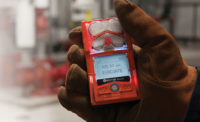Consumer electronic waste is a serious problem. Americans replace their cell phones every 22 months, on average, leading to over 140 million cell phones in U.S. landfills annually. Over time, the components in those phones break down, allowing toxic substances to leach into the surrounding soil and water systems. The problem is so significant that electronic waste is often exported, sometimes illegally, to developing countries where it winds up in vast toxic wastelands.
Some countries have taken a proactive approach to reducing the environmental impact of electronic waste. On June 8, 2011, the European Union passed Directive 2011/65/EU which prohibits the sale of electronics with the hazardous substances lead, cadmium, mercury, hexavalent chromium, polybrominated biphenyls, and polybrominated diphenyl ethers. The aim is to reduce human exposure to the hazardous chemicals by preventing them from ending up in landfills in the form of discarded televisions, cell phones, computers, and other electronics. Repeated lead exposure, for example, can cause significant health risks such as kidney failure, high blood pressure, and cognitive decline. Even when contamination levels are low, exposure can be devastating.
Gas detection and electronic waste
Gas detectors are a critical piece of safety equipment. Efforts to make sure that those same gas detectors don’t cause lead poisoning, for example, only make sense.
Because sales into many European countries require compliance with the prohibited substance regulations, most gas detection manufacturers have designed instruments that comply. But if you have hundreds of gas detectors on site and they only last a year, a significant number will wind up in landfills. Even without the hazardous substances prohibited by the European Union, disposable gas detectors make an impact on the environment. What can you do to make your gas detection program more environmentally friendly?
The answer: reduce, reuse, and recycle.
Reduce
Do you keep a pool of extra instruments around just in case of an instrument failure? There are numerous ways to reduce the number of instruments you keep on hand, including service programs and fleet management features.
Service Programs – When one of your instruments is in need of repair, you can order the parts, wait for delivery, and then service the instrument as you have time. Days or weeks may pass by. The hassle of the entire process can be virtually eliminated through the use of software that provides data about the status of your instruments and service programs that provide replacement parts or instruments automatically.
Fleet management – The ability to assign instruments to specific users and then easily change those assignments can reduce the size of your instrument fleet. Keep only the total number of instruments that may be in use at any one time. Allow users to assign those instruments as they check them out. This greatly reduces not just your impact on the environment, but your overall gas program budget.
Reuse
A well-made gas detector can last years if it is properly serviced. Look for upgradeable firmware, replaceable batteries and sensors, and other service features that can be significant tools in helping you reduce your environmental impact.
Upgradeable firmware – Electronic devices can become obsolete the second we take them home, but there are gas detection manufacturers who enhance existing technology. Free firmware updates for the life of the instrument, for example, can allow you to continue to use the latest tools without throwing away hardware.
Rechargeable and replaceable batteries – Batteries are a significant source of negative environmental impact. Instruments that are designed to run for a length of time and then be discarded make a bigger environmental impact than those that allow you to recharge and/or replace the batteries. Why not spend a few dollars on a battery and then continue using an instrument for several more years?
Replaceable exterior filters – If you drop an instrument into an oil-filled puddle, you shouldn’t have to retire the entire instrument. Effective filters can protect the sensors from many forms of contamination and damage. Replaceable exterior filters can be peeled off and replaced in just moments, keeping the instrument running with minimal cost and impact on the environment.
Recycle
Components in a gas detector can often be recycled. Whether it’s a matter of properly discarding the instrument or taking advantage of manufacturer service programs, you can help keep gas detectors out of landfills.
Guarantees – Look for instruments that are guaranteed for the life of the instrument. The manufacturer is then responsible for making any repairs that are needed as a result of normal use and they will responsibly recycle parts as they work to honor that warranty.
Service programs – The same service programs that provide a replacement instrument any time you have a problem with your equipment allow manufacturers to responsibly recycle components.
Calibration cylinders – Be more efficient by purchasing the correct size of calibration gas cylinders. Some gas detection manufacturers can assess your calibration gas usage and help you to order appropriately. If you buy too small, you’ll be replacing cylinders more often than necessary, which is expensive and creates a bigger environmental footprint. Buy too big and you’ll likely end up with expired calibration gas. Auto-replenishment programs can make sure you are being as efficient as possible with your gas cylinders. Once your cylinders are empty, check the bottle. Aluminum gas cylinders can often be recycled locally.
While it will take decades to make significant advances in the amount of electronic waste that is already in landfills, we can work daily to prevent the problem from worsening. Reduce, reuse, and recycle as a part of your gas detection program and you’ll be doing future generations a favor, while also saving time and money today.



